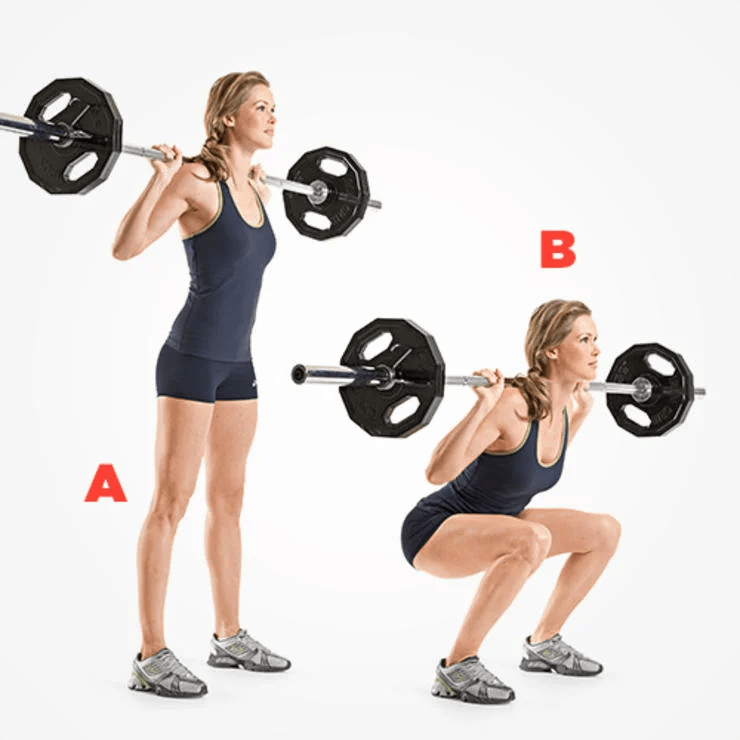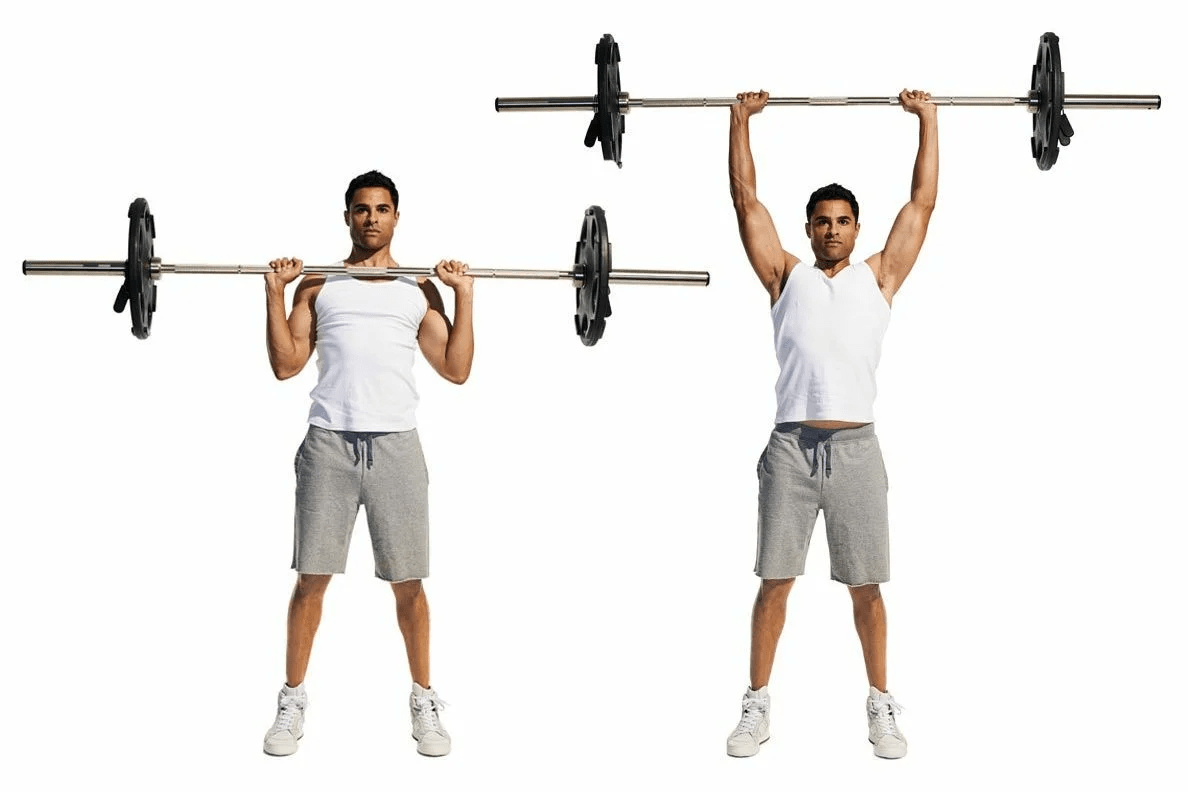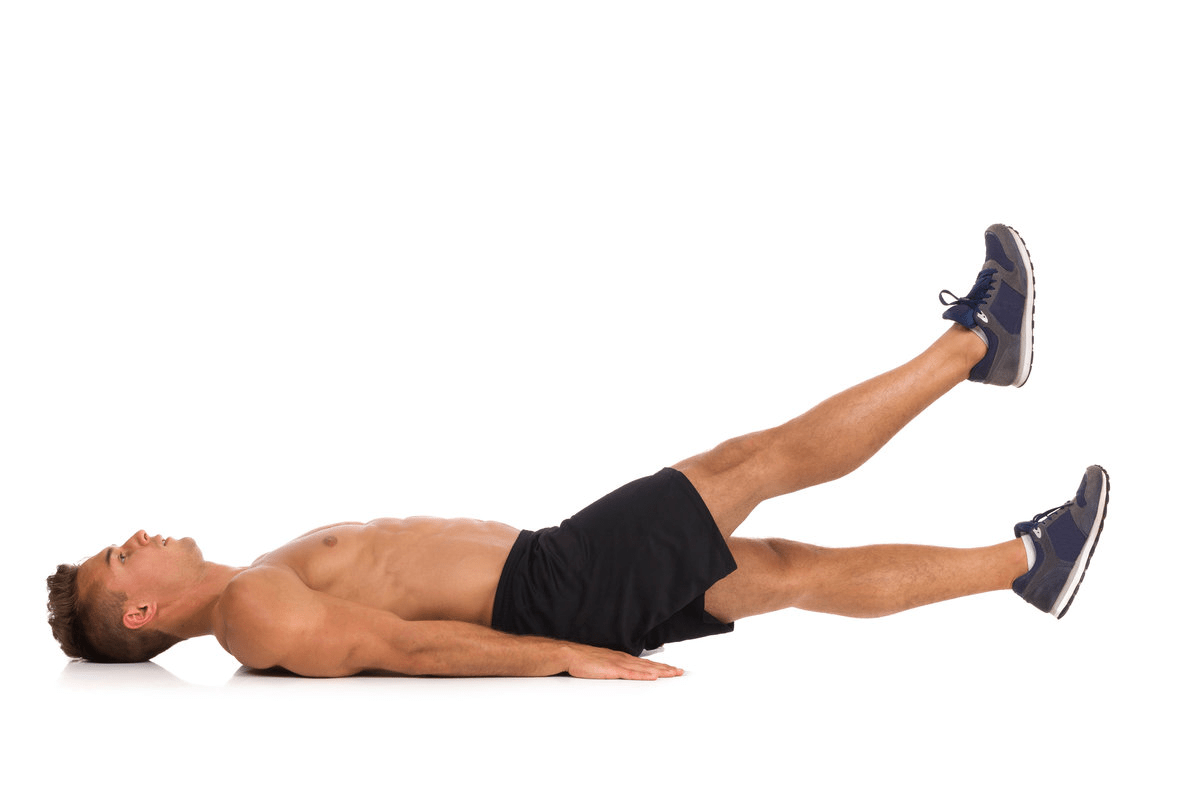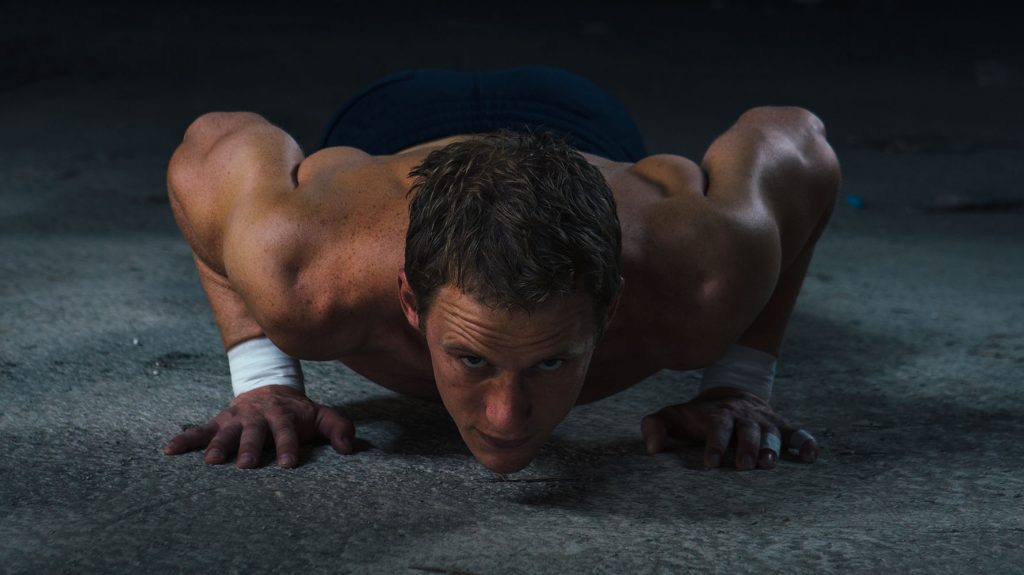Nowadays it is no secret that the greatest increase in muscle mass is provided by the implementation of these basic exercises.
For a beginner, two workouts per week, consisting of multi muscle group exercises, are enough to increase muscle mass and strength, providing that proper nutrition is consumed for the best quality and recovery of your muscles.
5 Best Full-Body Exercises for Beginners

1. Barbell Squat
Squats target the lower back, legs, hips and buttocks. You can also train your calves by standing on your tip toes at the end of the push motion while performing the squat. Squats are a great way to build overall strength and power within the body, as the movement focuses on many different muscle groups at one time.
Squat exercises are great for a total lower body workout. They effectively work most of the major muscle groups within the butt, hips and thighs. Squats are also a versatile exercise. They can be done in almost any location, with or without the use of weights or equipment.
There are many great benefits which come from this exercise including;
Squats tone the legs;
Squat exercises thoroughly engage the quadriceps, hamstrings and calf muscles, which helps to tone and strengthen the legs. Slowing the motion down can really help to focus on these muscles and makes the workout that much more intense.
Helps to strengthen the glute muscles;
Doing squats gives the glutes a powerful workout, helping to tighten and lift the “bum muscles”. To increase this effect, you can give your glutes an extra squeeze when returning to a standing position to ensure that they are receiving the maximum effects from your squat.
Strengthens your core muscles;
Squats engage the core muscles of the body. Abdominal and back muscles are needed to keep balance and posture during this movement. The result is a tighter, flatter abdomen and a stronger lower back. Please note that it is important to hold in your abdominal muscles while squatting down to increase this effect and make sure no other injuries occur.
Increases your flexibility;
Doing squats increases your joint flexibility. The ankles, knees, hips and lower back are all utilized in this squatting motion. Be sure to maintain proper form and technique to avoid injury. If you feel any pain in these areas, stop doing the exercises until the pain is gone again to avoid long term injury.
Upper body workout;
Adding weights to your squat routine engages the muscles of the upper body, essentially giving you a full body workout in one exercise. You can accomplish this with the use of a barbell, dumbbells or a weighted vest, this comes down to personal preference. When adding weights to your routine, please note that it is recommended to start with lighter weights and build your weight load as your strength increases.
How to Do Barbell Squat?
- Stand with your feet hip width apart.
- Tighten and pull in your abdominal muscles.
- Lower your body as if you were going to sit in a chair. Keep the motion slow.
- Stop when your legs are parallel to the floor.
- Stay in this position for a few seconds.
- Now press down onto your heels and slowly rise back up to a standing position.
- Repeat the exercise for a total of the designated reps and sets needed.
- Be sure to rest for 60 to 90 seconds between sets.

2. Deadlift
Deadlift target and use the legs, glutes, hamstrings, quadricepts, abdominal muscles, lower back, latissimus dorsi (lats), arms (especially for grip strength), and the obliques. Deadlifts Have been favored within the fitness industry for many years mainly by bodybuilders and powerlifters. This is because this gold standard compound exercise is known for building up good overall strength throughout the body.
Compound movements like the deadlift can make your workout more efficient. Instead of doing a separate exercises for your legs and back, you can do the deadlift and work them all at the same time. That gives you extra time in your workout to train other muscles or do other exercises.
Since the deadlift involves picking a weight up from the ground, you need to be concerned about your lower back. Because you start the deadlift from a bent-over position and if you’re not careful, you can strain your back while lifting. That’s why it’s important to have an experienced lifter or personal trainer watch you while you deadlift when you start learning this movement for the first time, as they can check your form to make sure it’s safe.
There are many benefits that come with this compound movement such as; increased cardiovascular endurance, you can burn more calories if done correctly that you can from running and you increase your primary Anabolic hormones that stimulate fat loss as well as muscle growth. These are just a few of the positive benefits that deadlifting can bring to the table.
How to Do Deadlift?
- Step up to the barbell and place your feet just under the barbell, with your feet angled slightly outward, at hip width apart.
- Bend over and grip hold of the barbell with both of your hands placed at shoulder width apart.
- Bend your knees until the bar almost touches your shins.
- With a neutral spine, flex your butt (glutes) and brace your stomach (abdominals).
- Pick the bar up off the ground, pushing down through the heels of your feet and keeping your back straight with a good posture. Remember technique is key so that you do not give yourself an injury.
- Continue pressing down with your legs until the barbell passes your knees, then thrust your hips forward until you are standing up straight.
- Reverse your movement until the bar returns to its starting place on the ground. When coming back down, do this slowly and avoid “jerks” or just letting the weight go, as this could lead to injury.

3. Barbell Bench Press
Bench Press is one of the golden standard of exercises for your upper body. When we push with this exercise it uses the chest muscles, triceps, shoulders, abs and latissimus dorsi. This compound movement is one that is associated within the fitness industry as “weight lifting”. Many people find this compound movement one of their favorites.
Bench press is actually a fairly simple exercise, simple yet hard. It involves lying down in a supine position, or in other words, flat on your back and this is usually done using a bench, hence the name bench press. This is actually one of the three exercises which bodybuilders and powerlifters use when weight lifting. It involves lying on your back and pressing a designated amount of weight vertically upwards from your chest until your arms are extended. Although the bench press is commonly known to weight lifters, this exercise is very versatile and can be used with light weight to burn fat, help tone or define muscles and also as a cardiovascular exercise if the repetitions are very high.
There are many benefits that come with having the bench press exercise within your training regime, similar to the other compounds exercises, when you bench press, you use may different muscle groups to perform this action. Using these muscle groups can have outstanding effects with posture, bone health, general strength such as your pushing motions along with added grip strength and these are just a few. It is recommended that when you are first starting to bench press (especially with weight), to find an experienced gym user or a trainer from in a gym, to watch and make sure that your technique is correct. If you have a bad technique, you can easily bring your shoulders into the push and this can be risky as you can easily tear ligaments within your rotator cuff, which is not pleasant.
How to Do Barbell Bench Press?
- Lie on your back on a flat bench. Grip the barbell with your hands slightly wider than your shoulder-width.
- Press your feet firmly onto the ground and keep your hips on the bench throughout the entire movement.
- Slowly lift the bar off of the rack and lower the bar slowly to your chest, allowing your elbows to bend out to the side.
- Stop lowering when your elbows are just below the bench or the bar is just above your chest. Press your feet into the floor, as you push the bar back up to return to the starting position.
- Perform the amount of reps and sets needed, depending on weight used.

4. Overhead Barbell Press
The overhead barbell press is one of the common exercises that people use within a gym or people use this exercise who have weights and use these within their home workouts. Although the overhead barbell press is not as tough on the body and powerful such as, deadlifts or squats. This exercise can define and tone your upper body and shoulders really well. This exercise focuses mainly on the; pectorals, front and rear deltoids, triceps and trapezius muscles. The overhead barbell press is very popular and used within HIIT training (high intensity interval training).
This exercise has been around for many years within the world of fitness and is one of the favorites within the gym setting. The overhead barbell press was used many years ago in the Olympic Sports and was known as “The Press”. Sadly, after much controversy this was removed from the sport by the Olympic committee in 1972. This exercise was such a good way for building strength and endurance, even people before the days of gyms and barbells, would use a big pole with sandbags each side to be able to press!
Some of the benefits associated with the overhead barbell press include;
Getting a full body workout – Although when using this exercise, your upper body muscle groups are worked on, it actually works on your lower body muscle groups as well. This is due to the lower muscle groups such as; the legs, the glutes, the lower back, the lower abdomen and the hips and pelvis, are all used to help support your body within its posture and stance, so that it is able to hold its form while you are pushing the weight.
Build upper body mass and strength – According to the principal of progressive overload, you must increase stress on the muscles over time to build muscle mass. So the overhead press is a top choice for building muscle because the potential for progressive strength gains is practically unlimited.
Increase your lockout strength – You train your lockout strength by fully extending your elbows on each and every repetition. This improves your ability to power through at the end of heavy repetitions that would otherwise end in an intense, drawn-out struggle to move the bar just two more inches! This lockout strength transfers to all other exercises that involve an elbow lockout. This is more commonly used within HIIT training.
Safeguarding your shoulders – This exercise offers the benefit of improved shoulder health and protection against injuries only if this is done correctly. First off, it makes the shoulder muscles stronger in general. Second, and most important, it trains the anterior deltoid, lateral deltoid and posterior deltoid (front, side and rear) relatively evenly, which helps maintain proper muscular balance and will help keep your rotator cuffs healthy.
These are only a few benefits which this exercise can bring to the table. Please let it be noted, that although this exercise has many great benefits, it also can have many risks if your form and technique are not correct. These can include shoulder and mainly back issues which can become a big problem for the sports person. It is recommended to have a trainer in the gym or an experienced lifter check your form to make sure it is correct, before you start adding any weight onto the bar.

5. Crunches
The abdominal crunch or scissor crunch, have been the primary form of ab workouts for decades. They target the rectus abdominis which is the six-pack muscle that runs along the front of the torso. Building this muscle is one part of developing your core muscles for stability and performance. Crunches can be part of a core strength workout or a total body workout, this comes down to personal preference. The joy of these exercises are that they can be done anywhere, usually whether you are performing this exercise in a gym or within your household. This exercise is much more comfortable using a Yoga mat to lay on while doing your crunches.
How to Do Crunches?
- Lie down on the floor on your back and bend your knees, placing your hands behind your head or across your chest. Some people find that crossing the arms over the chest helps them avoid pulling on the neck. However, if you find your neck is strained, you can keep one hand cradling your head. If you are putting your hands behind your head, your fingers should gently cradle your head, rather than be pulling on your head. The idea is to support your neck without taking away the load from your abs.
- Pull your belly button towards your spine in preparation for the movement.
- Slowly contract your abdominals, bringing your shoulder blades about 1 or 2 inches off the floor.
- Exhale as you come up and keep your neck straight, chin up. Imagine you’re holding a tennis ball under your chin. This is about the angle you want to keep the chin throughout the entire movement.
- Hold at the top of the movement for a few seconds, breathing continuously.
- Slowly lower back down, but don’t relax all the way.
- Repeat for the number of repetitions and sets needed, with perfect form for each rep.

Scissor Crunch
For the scissor crunch, this is very similar to the abdominal crunch. It focuses mainly on building a good core strength which is required for good stance and posture, that is needed throughout any time within weight lifting of fitness exercise.
To perform the scissor crunch, this is very similar to the abdominal crunch, but instead we are going to be working on and targeting the lower abdominal muscles.
How to Do Scissor Crunch?
- Lay on your back flat, preferable on a yoga mat so that you are more comfortable.
- Lift your head slightly to a 45-degree angle.
- Lift your legs towards the roof or ceiling until they are nearly at a 90degree angle to the body.
- Then lower one of your legs back down towards the floor, you should feel tightness already within your abdominal muscles.
- Then as you raise one leg, you must drop the other leg at the same time, making a scissor type movement with your legs (hence the name scissor crunch).
- Repeat this movement over for your designated time and for the designated sets.
- If you find your neck is becoming uncomfortable or stiff, you can relax your head and keep it on the floor while you perform this exercise.
The Perfect Full Body Workout Plan for Beginners
This example is based on a two day per week workout plan, the other days not included are your rest days, this is the time your body needs to rest and recover.
Day 1: Monday
1) Squats – 2 warm-up sets and 5 working sets.
In the warm-up sets, squat with a light barbell 25-30 times. In working sets, we start with 20 repetitions and reach down to 8, increasing the working weight with each set.
2) Bench press – 2 warm-ups and 5 working sets.
Warmup sets – 20-25 repetitions. Working sets – 15 to down to 5 repetitions, increasing the weight of the bar with each set.
3) Crunches – 4 sets of 20-30 reps.
Day 2: Thursday
1) Deadlift – 2 warm-up sets and 5 working sets.
Warm-up – 15-20 reps. Working reps – from 12 down to 6.
2) Overhead bar press – 2 warm-up sets and 5 working sets.
Warm-up set – 15-20 reps. Working reps – from 15 down to 5.
3) Scissor crunch- 4 sets of 30 seconds per set.
This program includes the best and most basic compound exercises for beginners. At first isolated exercises are not needed, as before an athlete can start to isolate the muscles that they are working on. They first need to build up and develop the muscles that are going to support your movements and that will enable you to work on and isolate particular muscles. These exercises we have shown within this program will ensure that you will develop each muscle group that is needed to be able to move onto isolated exercises.
When you gained your first 5-6 kg of muscle mass with basic workouts, or even developed the muscles that help support and stabilize your physique and posture. Then you can move on to more complex training programs with exercises for different muscle groups.


